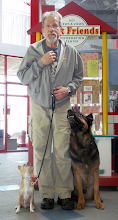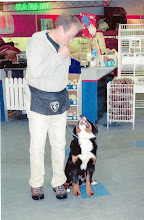It is nice to select a puppy that wants to interact with the owner by playing with toys in the beginning. For experienced trainers this is a part of the selection process because a goal has already been estlabished and to pick a partner with the same interest will aid in training.
There are training organizations that require your dog to retrieve a wooden dumbell sometimes up to 3 pounds. There are people who have a dog that will retrieve anything except a dumbell. Why do you think that is? Pressure. For the first time the dog has to get something without play value, or so the handler is told or believes. Here comes the age old question and debate, play or force. I've had many discussions over the value of each. Those that force say there is more reliability. There is the Koehler method, e-collar, and, etc. I believe the play method using the natural instinct for prey is more motivational and a dog trained in this manner will usually go quicker and more happily than a dog that is forced. It is possible to force and with practice and positive communication also have a dog that will return quickly and top trainers are flexible and can apply a combination of all techniques. Although too many times with the pressure from a trial or competition when the handler gets stressed or the e-collar is removed the dog will no longer retrieve.
Unfortunately housebreaking issues often come between a handler and a dog that will listen. To often, "come" or "here" means, I'm putting you in the crate, cutting your nails, showing you the molding or chair you chewed or the poop in the living room.... If you have a dog that will not come because they associate coming to you with disclipine they will avoid coming. If you want to play sometimes the dog will not come to you because he fears you will take the toy away and this causes avoidance. This is why fetch should be taught with a dog on a leash. #1) They must come. #2) You can play tug. This builds drive which can ultimately be used to motivate and also if you play tug or, "rock & roll" as I refer to tug, the dog will enjoy the interaction more than having you chase them for the toy. Dogs need to think of the fun they have with you in terms that you define. Once you play tug it is okay to let the dog win the prize and carry it while heeling. While walking or a call to front, I'll grab the toy preferably by the handle. I like a ball or kong or rolled burlap with a handle or rope. I only play if the dog has his end (the wet end).
I currently have a client's dog who only will get one ball and will not release it. In order to teach the fetch I think it would be dangerous to stimulate play/prey drive holding a 3-4 inch diameter ball in my hand. Training involves teaching the dog which end is his in a safe and controlled manner. There are important rules for tug. I believe if you control the games you control the dog. There must be "out" which teaches the dog that even though he has won the prize he must relinquish it to you. This is a controlled game that must be taught by adults. Dogs need to learn they must give, "out" to our kids and with our help carefully make sure the dog does not learn he can take anything from what he considers his siblings or littermates. There are trainers that say tug is dangerous and makes dogs mean. It will make them dominant if they think they can win whenever they want any time they wish.
When we build drive and then control it we then use it to motivate the dog. Carry the ball to get eye contact while heeling, reward for a quick sit by throwing "bring," or call to front and throw the ball for a reward after a close sit. At first we use food to bait, later it can become a reward for doing what we asked but there is nothing more motivational than paying with a toy that is the source of the drive we build.
The goal or target should be kept in mind. Do not hope the dog will get the item then pray he will bring it to you then hopefully he will give it to you. Be patient, go slow, teach and most important do not let your dog see stress or frustration because it will set you back. Trainers must be flexible in their approach and watch for signs of avoidance. Don't keep doing the same things that are not producing what you want
My dog, Pflash will sit next to me and wait as I throw the dumbell or ball on a rope. I say, "bring" and he runs fast to get it and brings it back to me. He sits in front of me and holds it until I ask for it, "out." Then I say, "heel" and he finishes and sits next to me. If I had him do that every time he would not go as fast or have as much fun and that's because he only has to perform once and most of the time its play. I do not encourage too much tug with a dumbell because it can cause chewing but in the dogs mind its important it's just another toy. I also would not teach the retrieve over a jump or scaling wall until the retrieve on the flat is perfected. I will practice the jumps without a retrieve just going over and back. Good Luck and remember the faster the retrieve the better it looks.
Sunday, April 11, 2010
Subscribe to:
Post Comments (Atom)









No comments:
Post a Comment